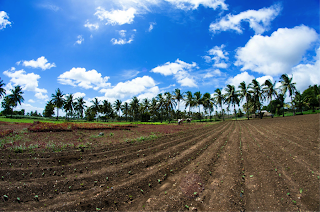
Farming pushes forward using alternate irrigation sources (wastewater and borewells) during a weak monsoon season in Southern India in 2012. Photo Credit: Sharada Prasad CS
Pre-monsoon days in the city of Dharwad are peppered with the rhythmic honks, beeps and stops of barreling buses, autos, cars, motorbikes, parades and swarms of people rushing to work or to the market. Spending three months last summer for field research in central Kannada, the daily buzz of life in India transformed from the jarring whirlwind of my first week – 40°C traffic maze, an obstacle course– to a steady, deliberate hum of humanity, existing. This is indeed a poetic rendering, but my perception of the noise, heat, and busy streets truly changed, and I began to love what the street symphony of life in India actually echoed: kids whizzing by, 12 to an auto, backpacks bulging but perfectly oriented, from the rickshaw doors; boys herding buffalo throughout the unconstructed, green patches of land in the city; the hours of cooking – rolling roti, pressure cooking rice, sautéing okra, capsicum, eggplant, spices, spices, and more spices; the deep, cultural connection of most people to their family, their religion, and to India.
This impression is not unique where India is concerned in the blogosphere. Many a traveler pass through this enormous, history and culturally dense place with visions to be revised, expectations that turn inside out, and notions that fall flat as fictions after just one night in the coach car rail. The railroads are veins of lifeblood in India, connecting the smallest towns to the world’s largest cities, and they seem to shape the experience of all that they carry. While I swallowed the guilt of my cinematic romanticism, the moment I jumped onboard the first train to visit our colleague’s family home in Davanagere, scenes of Darjeeling Limited (Wes Anderson’s brilliant film set some 2,500km north of where I actually was) flooded what was forming as memory—the enormous insulated bags carrying home cooked meals for the long journey ahead; the smell of samosas, dosas, and the sound of chai wallahs singing their hot spiced milk tea; and of course the rainbow of textures and colors flowing around me. There are no dull moments on the trains save for the late hours on overnight sleeper car rides, where solo travelers are treated like guests by traveling families. Being poorly prepared without a carry-on meal (though slightly excited to try the suspect train food) on another journey for 24 hours between Hubli and Ahmedabad, families around me quickly filled up plates of food and fed me until I was too full to imagine ever eating again. I stared for hours on end at a countryside whose red soil and palm trees slowly morphed into the drier and less tropical north-west. The land seemed limitless and empty despite holding over 1.2 billion people, until I realized I had been staring at farmland for nearly the entire journey – the earth-pantry for 1/6th of our planet!
Much of this farmland is dependent on the freshwater from yearly monsoons, but the weak rains of 2012 made it clear that farmers reliant on the monsoons for freshwater irrigation were going to suffer. Agricultural production in the country was vulnerable to extreme uncertainty around when and why annual precipitation was 12% below average, a rate that when scrutinized month to month and by region reached percentages as high as 70% in July for the Punjab region. The WMO anticipated that climate change will increase the erratic nature of draughts – having effects from the micro to macro scale (food prices increased 7% between April and July 2012 primarily in response to high grain prices, crops severely affected by global draughts). Returning to the U.S. in mid-August to a similar state of draught-induced fear for food prices and farmer livelihood after the hottest year on record across the U.S., the reality of our global connectedness and the consequent unified environmental impact felt more heightened than ever.
Let’s hope and work towards renewed consciousness and stronger environmental policy for 2013. Keep your eyes and ears well tuned on ERG’s blog and with some great voices in the blogosphere on the climate and environment subject: Guardian’s Environment, NYT’s Green, Orion Magazine’s blog, Real Climate, Climate Progress, Grist, Environmental Graffiti.